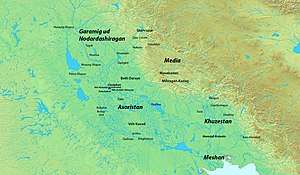Veh-Ardashir
Veh-Ardashir (also spelled as Beh-Ardashir and Weh-Ardashir), was an ancient Sasanian city in present-day Iraq, and formed a suburb of their capital, Ctesiphon.

History
Originally known as Seleucia, the city was rebuilt and renamed in 230 by the founder of the Sasanian Empire, king Ardashir I (r. 224-240). The city was known as Mahoza by the Jews, Kokhe (Syriac) by the Christians, and Behrasir by the Arabs. Veh-Ardashir was populated by many wealthy Jews, and was the seat of the church of the Nestorian patriarch.
The city was walled and was circular by design.[1]
A governor marzban (general of a frontier province, "margrave") is known to have resided in a fortress in the northern part of this city in ca. 420. During the mid-5th century, a flooding occurred in Veh-Ardashir, which divided the city in two. This resulted in a decline of the city, and the abandonment of many parts of the city. During the reign of king Khosrau II (590-628), a palace was constructed near a garden named Bagh-i Hinduvan (meaning "the garden of the Indians"). In 636, Veh-Ardashir was captured by the Arab general Khalid ibn Urfuta during the Muslim conquest of Persia.
References
- Morony, Michael. "MADĀʾEN – Encyclopaedia Iranica". www.iranicaonline.org. Retrieved 9 May 2019.
Sources
- Fisher, William Bayne; Yarshater, Ehsan (1983). The Cambridge History of Iran: The Seleucid, Parthian and Sasanian periods. Cambridge University Press. ISBN 978-0-521-24693-4.
- Pourshariati, Parvaneh (2008). Decline and Fall of the Sasanian Empire: The Sasanian-Parthian Confederacy and the Arab Conquest of Iran. London and New York: I.B. Tauris. ISBN 978-1-84511-645-3.
- Howard-Johnston, James (2010). "ḴOSROW II". Encyclopaedia Iranica, Online Edition. Retrieved 25 October 2014.CS1 maint: ref=harv (link)
- Kröger, Jens (1993). "CTESIPHON". Encyclopaedia Iranica, Vol. IV, Fasc. 4. pp. 446–448.CS1 maint: ref=harv (link)
- Morony, Michael (2009). "MADĀʾEN". Encyclopaedia Iranica.CS1 maint: ref=harv (link)
- Morony, Michael (1989). "BEH-ARDAŠĪR". Encyclopaedia Iranica, Vol. IV, Fasc. 1. pp. 93–94.CS1 maint: ref=harv (link)